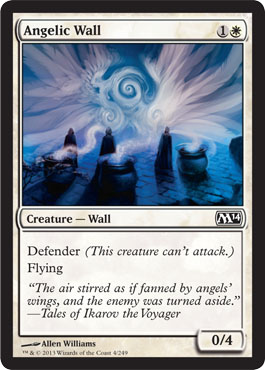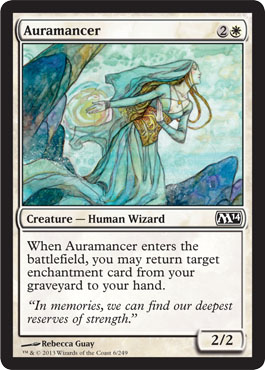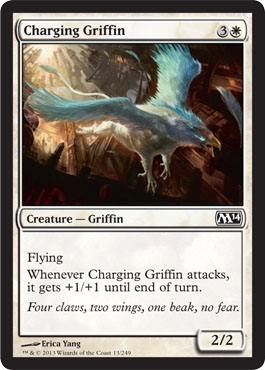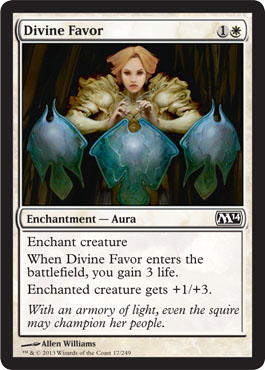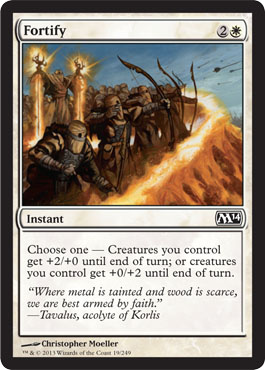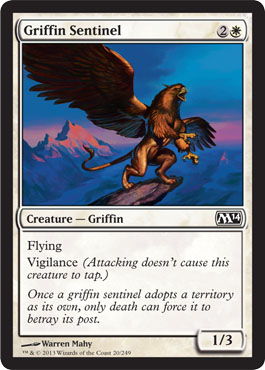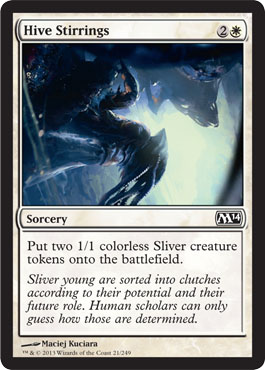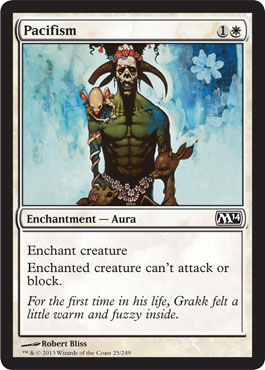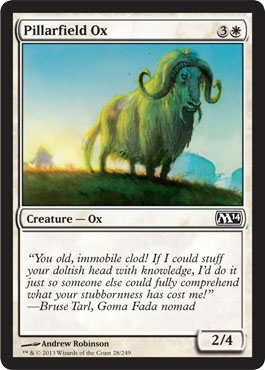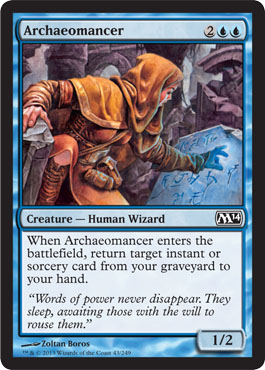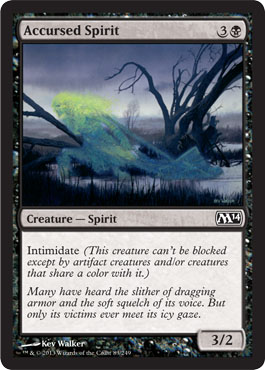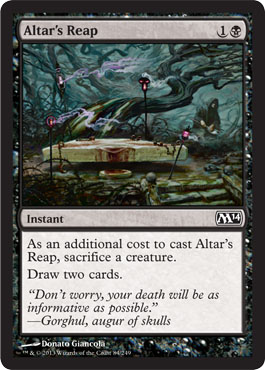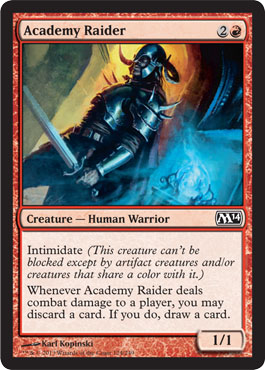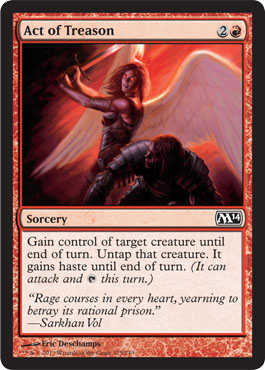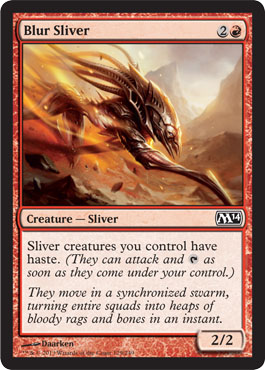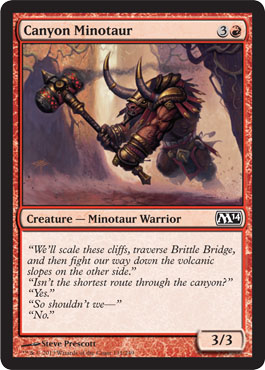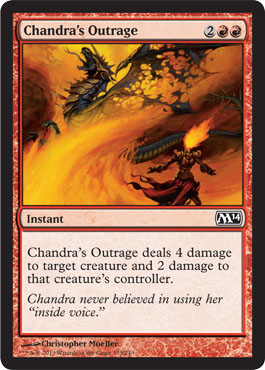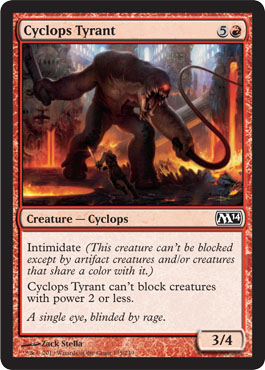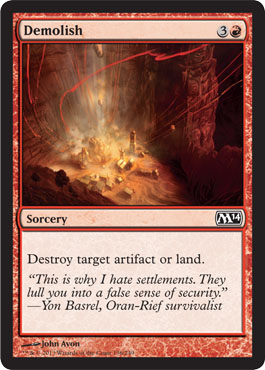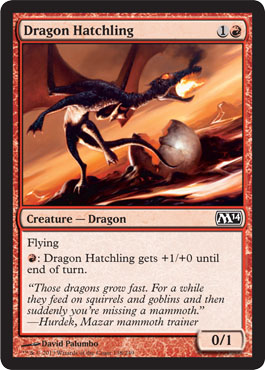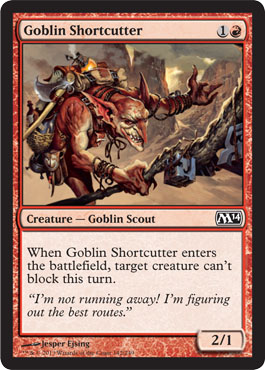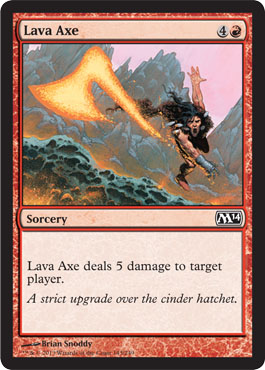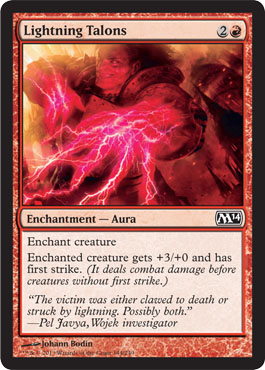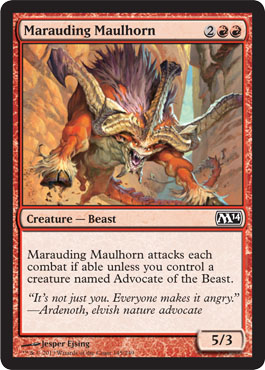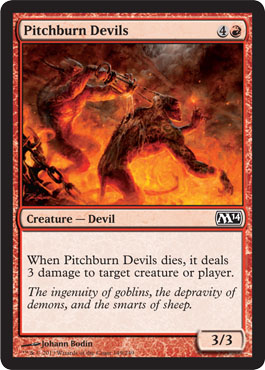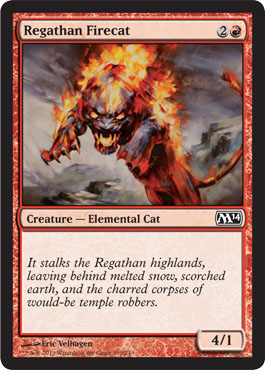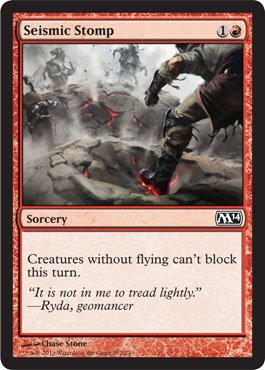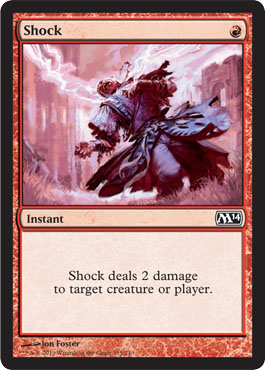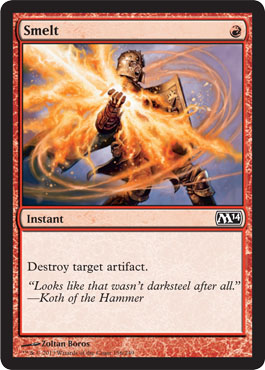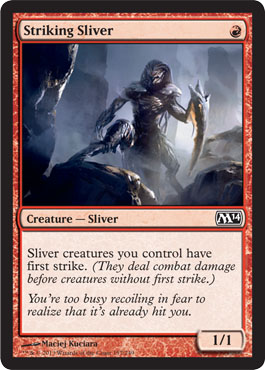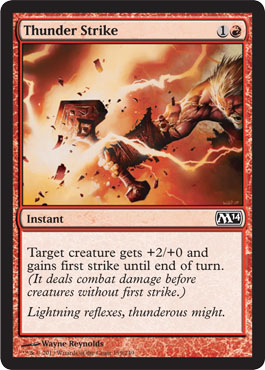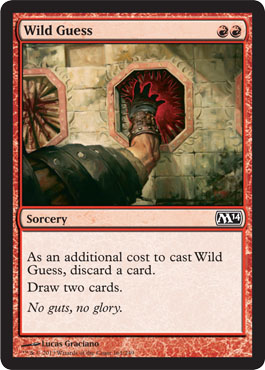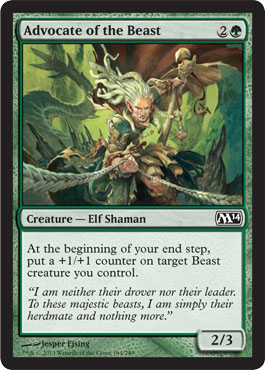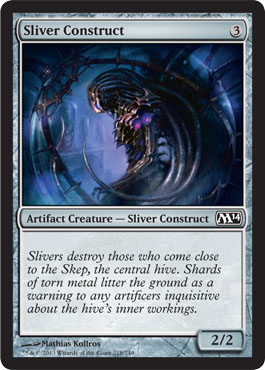Magic 2014 is out this weekend, and players around the country will be cracking sealed pools at pre-releases and trying to puzzle out color combos, playables and unplayables, synergies, and combos. With that in mind, I tapped Hipsters’ other resident Limited expert, Drawing Live’s Zach Barash, to tag-team with me on a review of all the 101 commons in the new core set—followed by another tag-team review of the 60 uncommons on Tuesday, in Zach’s Drawing Live column.
These cards, though—the commons—represent the bulk of what you’ll be facing this weekend, so study up and X-0 your local pre-release! Also let us know in the comments what you agree and disagree with us about! Oh, and so you can know who to blame, each card review will close out with HRS (Hunter “Rolex” Slaton) or ZB (Zach Barash). So without further ado, let’s get into it!
WHITE
Angelic Wall—A relatively unexciting card, but in a controlling build it’s a fine include. A key thing to note, right off the bat here, is what is the (lowercase-m) magic power and toughness numbers in this set? What’s going to block everything, and what’s going to eat everything? At first glance, a four-butt in the air looks like it’s going to hold off pretty much everything. (HRS)
Auramancer—She’s a Gray Ogre with upside. A 2/2 for three doesn’t seem terrible in a format filled with two toughness creatures, though those stats are hardly impressive. Her ETB effect can provide incidental value through retrieving Lightning Talons from a slain creature or a Naturalized Pacifism). She may be best in a white-black deck where she approximates Nekrataal by recurring Quag Sickness and buys lots of tempo with Mark of the Vampire. (ZB)
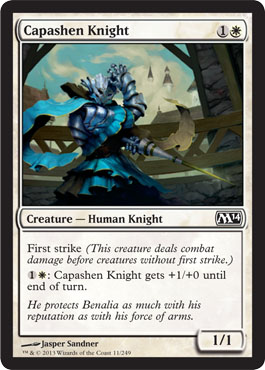
Capashen Knight—This guy has a decent threat of activation, meaning that for at least the first few turns of the game, he’ll be able to swing in relatively unopposed. If they block with an X/2, you can just pump him and win combat—which means, of course, that usually they won’t block. But even in that best-case scenario, you’re only getting in for one damage. If this guy cost one mana, that might be OK—but a conditional “bear” (even a bear with first strike) just doesn’t get the job done. One thing to note: This guy loves wearing a Divine Favor. Gaining three life on T3 and swinging in with a 2/4 first-striker that on T4 you can pump to be a 4/4 if need be is kind of big game. The usual rules about being careful when you try to stick your enchantments apply, but I think this could be worth it. (HRS)
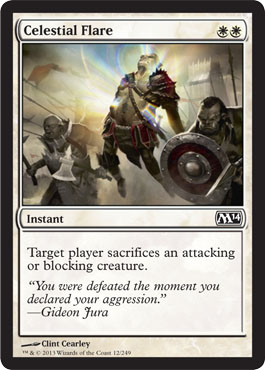
Celestial Flare—This effect has never been done before. It’s similar to Dispense Justice and Wing Shards, except it also works when you’re attacking. I love it; it’s a situational Diabolic Edict that you can scale by crafting favorable combat situations. If you control a Pillarfield Ox, your opponent is likely to only attack with her Marauding Maulhorn, leaving behind her Goblin Shortcutters.
It being WW means you’re not likely to splash this and will want a fair number of plains in your deck. I expect that this won’t be a top pick in draft (as there are more powerful/less conditional removal spells), but will be a reward to the dedicated white drafter. Granted, white seems quite powerful in M14, so there may be several such drafters.
Don’t forget that there’s an end of combat step. After all combat damage has been dealt and creatures have died, you can still fire off Celestial Flare and hopefully hit your desired target. (ZB)
Charging Griffin—We’ve had this card before, albeit on the ground, for 2W. A 3/3 flier on offense is quite good, but I feel like he’s a bit overcosted at 3W. And being able to survive blocking pretty much nothing outside of the 1/X fliers makes him pretty sad on defense, too. This is not what I want my T4 play to be. (HRS)
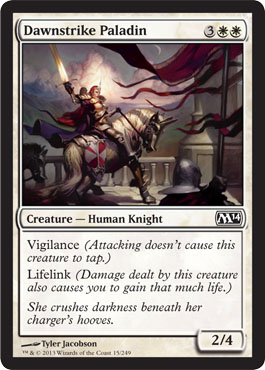
Dawnstrike Paladin—This is no Seraph of Dawn, but Seraph of Dawn was bonkers, so Dawnstrike Paladin could still be pretty good. Five mana is a lot to ask for, but she promises a fair amount—Lifelink is strong in Limited, and with four toughness and vigilance she can stabilize you against aggro while bashing in every turn. If you suit her up with a Lightning Talons or Trollhide, you should be in excellent shape. (ZB)
Divine Favor—Turning any random bear into a Siege Mastodon, plus gaining a few life to boot, isn’t the worst thing. In sets past, I’ve usually been happier than it might seem like I ought to be to have a Divine Favor in my deck. Once you can find a window to stick it, the +3 toughness pretty much protects it from most removal except for Doom Blade and Claustrophobia. It’s also worth noting that Unsummon is not in M14—albeit Disperse is—making it a little bit of a safer environment for enchantments (which makes sense, given that it seems there is a minor “enchantments matter” sub-theme in this set). (HRS)
Fortify—Ooh, a Time Spiral reprint. It’s a split card of Trumpet Blast (which might fit in an aggressive deck) and Shield Wall (which usually sits in a sideboard). It’s better than the sum of its parts, since it can counter a Shock, be a blowout in combat, or outright kill your opponent… but I’m still unconvinced. I’d never pick this highly and likely not be too happy to have it in my main deck. (ZB)
Griffin Sentinel—I actually kind of like this guy, as he pulls double duty: pinging for one in the air each turn, and hanging back to keep random X/1s or even X/2s at bay. The price is right, too. (HRS)
Hive Stirrings—If you’re not playing red or green, these tokens are staying puny. If you have Battle Sliver, Thorncaster Sliver, Megantic Sliver, or Predatory Sliver, then go nuts.
If you don’t have sliver synergies, I’m less enthusiastic. There are synergies with Fortify (which isn’t great on its, like Hive Stirrings), Path of Bravery (a powerful rare), Blood Bairn, Gnawing Zombie, and Ogre Battledriver, It seems that white has plenty of better commons to choose from, although in a slivers deck this can be an easier pick. (ZB)
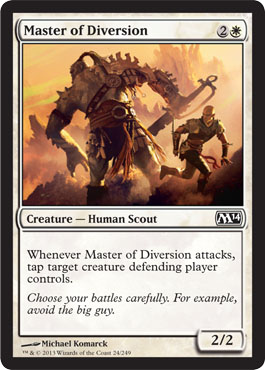
Master of Diversion—This card is straight-up bonkers. He is going to be a nightmare in draft, as anyone who is able to hoover up three or (god forbid) more of him is just going to destroy his or her opponent. Remember Haazda Snare Squad? Not only does this guy cost the same and his tap ability is free, but he hits harder. I don’t really think the -2 toughness matters, either, as this is a guy you want to be super-aggro with. Probably white’s best common. (HRS)
Pacifism—Another core set, another reprint of Pacifism, and another strong candidate for best white common. Unconditional, inexpensive removal remains fantastic in Limited, and Pacifism is exactly that. (ZB)
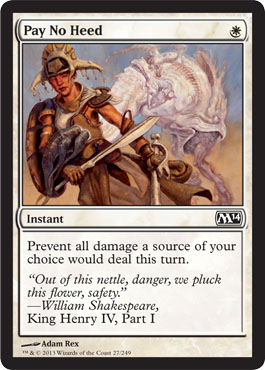
Pay No Heed—Unless I’m missing something, this is just a strictly better Shielded Passage. (Also, I love the real-world flavor text. I wish they would do that more often these days.) At the beginning of Gatecrash, I was happy to run a Shielded Passage in my Boros decks, as it was kind of a keep-battalion-going enabler—but given that this is M14, and protecting battalion synergies isn’t something you are going to be concerned with, I would mostly leave this card in the board until you see a bunch of burn from your opponent. Sure, you can gang-block a big green guy and prevent all the damage it would deal, but that just seems too round-about to be good enough to occupy a spot in your 23. (HRS)
Pillarfield Ox—Are you ready to COW YOUR ENEMIES? I sure am. Pillarfield Ox is never impressive but usually servicable. It holds the ground quite well—the only common creatures that can safely attack into it are Blood Bairn, Rootwalla, Rumbling Baloth, Minotaur Abomination, Marauding Maulhorn, and Groundshaker Sliver. Sure, it’s worse than Master of Diversions, Charging Griffin and Dawnstrike Paladin (again, white seems really deep in M14) and it’s a late pick in draft, but it’s still a fine card. With white likely being overdrafted, I’d expect this to be maindecked more often than sideboarded. (ZB)
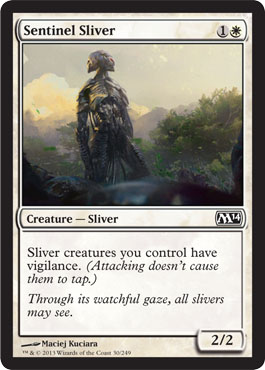
Sentinel Sliver—A strictly better bear that makes other of your—and only your—cards better? Yes, please. I’ll play these guys all day long. (HRS)
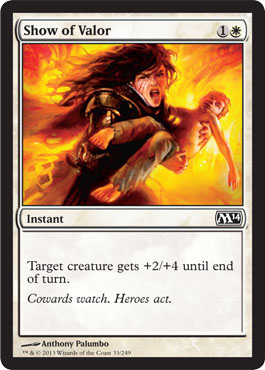
Show of Valor—A fine trick, if unexciting. White has a fair number of combat tricks (Brave the Elements, Celestial Flare, Fortify, Pay No Heed) which makes each harder to play around. I’d prefer a creature or a Mighty Leap over Show of Valor, but there are worse things than power of Pillarfield Ox. (ZB)
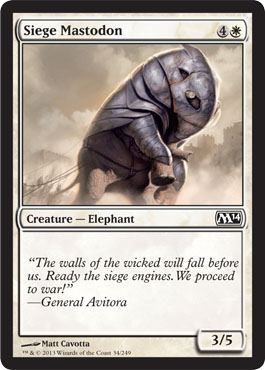
Siege Mastodon—Poor old Siege Mastodon. He’s always decent, and sometimes surprisingly frustrating for your opponent and good for you, but he never gets the love. There’s just usually more exciting stuff to be doing at the five-drop slot, I guess. Still, his stats are fine, and I don’t hate playing him—I just don’t often find myself doing so. He’s great against the green deck, I’ll say, as he blocks Rumbling Baloths all day long. (HRS)
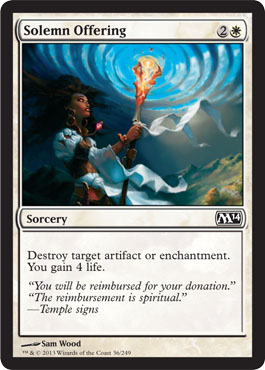
Solemn Offering—The sideboards demanded appeasement and, lo and behold, there was a Solemn Offering. There are ample powerful enchantments and auras worth bringing this in for. Haunted Plate Mail isn’t the easiest thing for white to deal with, short of a Celestial Flare, and this is white’s only answer to Dismiss into Dream and Primeval Bounty. (ZB)
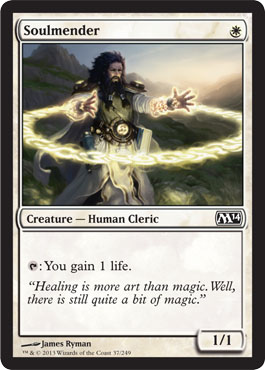
Soulmender—I don’t think this is a guy. Pristine Talisman was good, but it also ramped your mana. If he came on a bigger body—even, say, a 2/2 for three—he might be better; but as a 1/1 for one he just doesn’t do enough. Pass. (HRS)
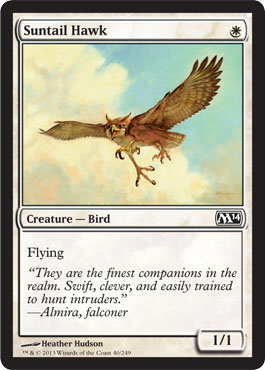
Suntail Hawk—A 1/1 for one, even with flying, is rarely good enough in Limited. All common flying creatures (excepting Dragon Hatchling and Trained Condor) have two or greater toughness, so Suntail Hawk shouldn’t often have favorable attacks or blocks. If your deck has auras or Haunted Plate Mail to improve your bird, so be it, but I expect it’ll sit in sideboards more often than not. (ZB)
BLUE
Archaeomancer—A card that is pretty much only as good as what you’re getting back it, Archaeomancer’s quality is really dependent upon what else is in your deck. She’s also a little bit worse in M14, I think, because in M13 she loved to chump-block a big exalted attacker for a turn, effectively gaining you three, four, or more life. There are also fewer—if any?—bounce effects in M14, which means you’re never going to be able to re-buy her ETB ability. Still, being able to re-buy Doom Blade is better than re-buying Murder, so if you’ve got the right build, run the wizard. (HRS)
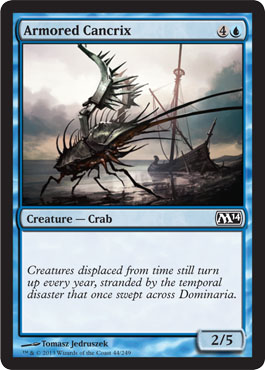
Armored Cancrix—Blue has a lot of solid fliers. Armored Cancrix can protect you as your Trained Condors and Nephalia Seakites peck your opponent to death. Otherwise, this expensive, defensive creature will probably be displaced from time in your sideboard. (ZB)
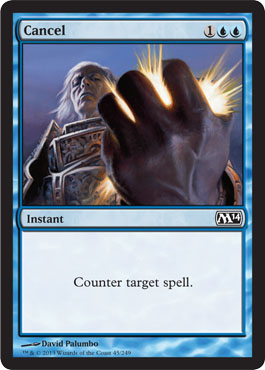
Cancel—Some people are against maindecking counterspells, but I’m happy to run a Cancel in the right deck, as it basically locks up games where you’ve been able to craft a commanding board state. You can’t argue with the fact that it’s a really strong spell. (HRS)
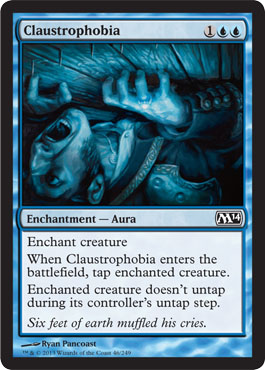
Claustrophobia—Unconditional removal… in blue! At common! If you’re playing blue control, this is probably your best common. However, blue seems geared more towards tempo than control, and Frost Breath and Disperse provide more tempo at less restrictive mana costs and instant speed. In any case, Claustrophobia is a solid card that should always make your main deck (if you can afford the double blue mana cost). (ZB)
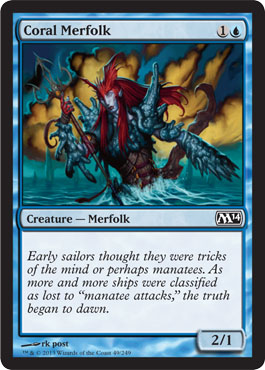
Coral Merfolk—Basically a bear, Coral Merfolk is fine—but I’ll quickly board him out against decks running those 1/X fliers like Griffin Sentinel and Seacoast Drake. (HRS)
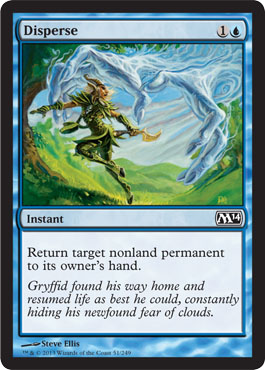
Disperse—Another reprint that continues a story through flavor text. Disperse, like Unsummon, is a pure tempo card; if you’re playing a fast deck with flying creatures, then it does everything you want by eliminating blockers, protecting your life total, and wasting your opponent’s time. If you’re playing a slower deck, it’s card disadvantage (unless you’re knocking off an aura). It gains additional utility by bouncing slivers mid-combat and wrecking your opponent’s carefully-crafted board. Whether this card is an easy inclusion in your 23 or sidelined depends on the speed of your deck. (ZB)
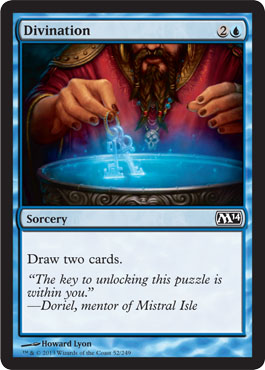
Divination—Love Divination. One is always great and two is often good. I think LSV likes to run as many as five, but he’s an amazing madman. Lesser mortals should probably cap out at two. (HRS)
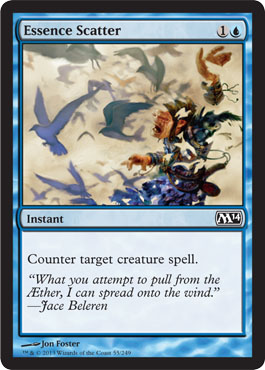
Essence Scatter—Remove Soul is still good. It’s effectively a second kill spell in blue, and unlike Claustrophobia, is splashable (not that one often splashes a counterspell). Essence Scatter plays very well with Nephalia Seakite, allowing blue players to switch between control and tempo while casting spells only during their opponents’ turns. Seems a solid common. (ZB)
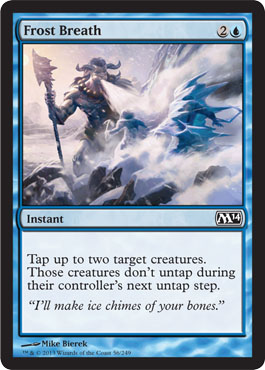
Frost Breath—A deceptively powerful spell, Frost Breath just straight-up ends games. In a blue deck with a couple decently sized fliers, it can but the brakes on opposing defenses or offenses right when your opponent desperately needs those defenses or offenses to hold. That said, I wouldn’t play more than one, as it’s a pretty bad defensive play, kind of like a mini-two-turn Fog. You need to be using it to kill your opponent, is what I’m saying. (HRS)
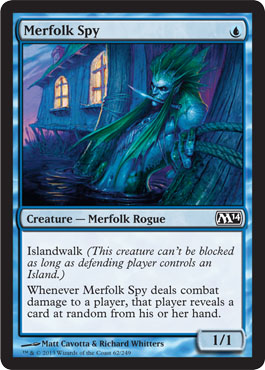
Merfolk Spy—I spy an unplayable. A 1/1 for one does not cut the mustard, and Islandwalk and a minor saboteur ability do not make this fish playable. (ZB)
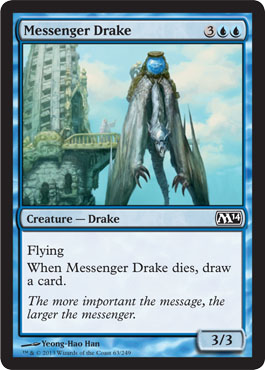
Messenger Drake—Cool (new) card! Kind of doesn’t feel like a common. I like him, but his stats seem a bit off. Like, when is he going to die? And if he’s not going to die, wouldn’t you just rather have a 3/3 for four? So I dunno. It depends how slow M14 is, and this guy might be totally fine even though he costs five, but I’m going to make a wager that Messenger Drake starts to lap the draft table a few weeks into the format. I could be wrong, but you gotta make calls. (HRS)

Negate—While Essence Scatter will always have targets, Negate may not. It does a great job of countering removal spells and dealing with planeswalkers, but I’d keep this in the sideboard and board it in. (ZB)
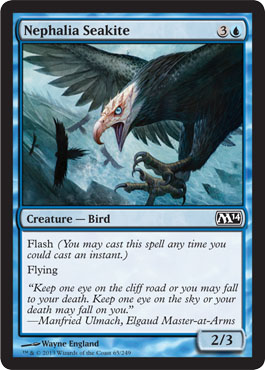
Nephalia Seakite—Now this flier I like a bit more. He’s going to eat a lot of bears, and then start cracking back for a two a turn—and he laughs in the face of Charging Griffins, at least on offense. He’s just got a lot of extra pluses here and there, specifically flash and an extra point of toughness, and that adds up to a good package. (HRS)
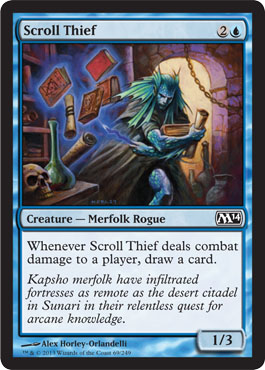
Scroll Thief—Ophidian remains a sweet card. This blocks 2/2s for days and if you can get in a hit or two with this rogue, you’re probably winning. The problem with Scroll Thief has always been getting him to do damage, but Trained Condor might be the newest addition to his Tricks of the Trade. Not a particularly high pick, since he’s neither evasion nor removal, but a reasonable inclusion in slots 15–23. (ZB)
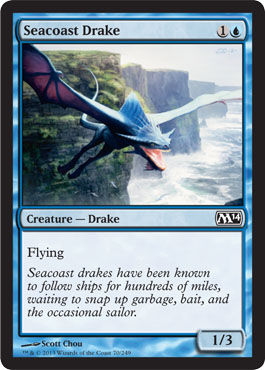
Seacoast Drake—Meh. I kind of hate this card, although the art is cool. Unlike Sentinel Griffin he can’t both attack and defend, and so really you’ve got a 1/3 wall for two? I suppose that’s not the worst, and three toughness is a fair amount … actually, now that I think about it, Drake could be OK. He’s relatively low-impact, but bears seem to be a bit of a thing in M14, and this guy blocks them well (he also blocks two-power fliers in the mirror). It’s worth noting, too, that he straight-up embarrasses Trained Condor, which we’ll get to in a minute. (HRS)

Sensory Deprivation—Or, as LSV refers to it, Swords to Plowshares. Sensory Deprivation isn’t as good as Claustrophobia, but it can still neuter opposing creatures and buy time for your fliers. This won’t always make my 23, but tempo/skies decks will appreciate such cheap ‘removal.’ (ZB)
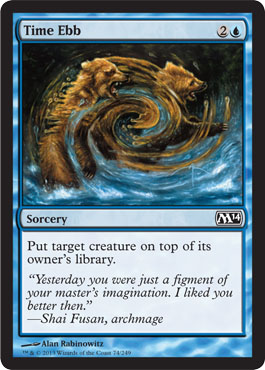
Time Ebb—Usually this type of effect comes at instant, and so it has combat-step implications. Also usually it costs much more. Is restricting this to your main phase worth the discount? I kind of think it is. It nukes auras, blanks draw steps, and clears out blockers. It’s kind of clumsy for blue, and I woiuldn’t want to run more than one (except perhaps in some super-aggro griefer blue deck, which could maybe be a thing?), but I like it. (HRS)
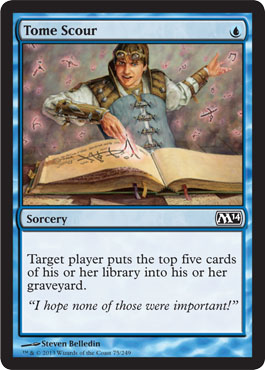
Tome Scour—If you want to be the person who grabs all the Tome Scours, Archaeomancers, and Millstones (and perhaps a Fog or three, then you might have a good mill deck. Otherwise, scour your maindeck of these. (ZB)
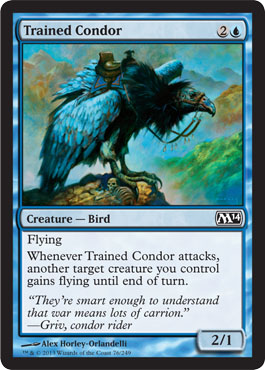
Trained Condor—I really want to like this guy. He’s aggressively costed and, depending on your other color, you can put some scarily big stuff in the air. I could see a UG deck with multiples of Condor and then green’s scary 3/3 for two and 4/4 for four. That seems fantastic. (Also this card has dope art; I love the color scheme.) Of course, youo’re going to be in a bad mood if your opponent drops a Griffin Sentinel or Seacoast Drake or two, after which point you’re just going to have to board Condor out—but that’s enough of a corner case that it doesn’t significantly damage my estimations of this guy. Note from Zach: Loves to make Regathan Firecat fly. (HRS)
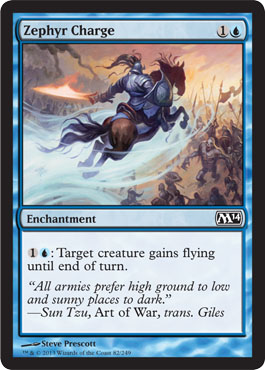
Zephyr Charge—It’s odd to have this and Trained Condor in the set together, though it does sell the idea of blue being “the flying color.” I was never a fan of Levitation, and making me spend mana each turn to Jump my creatures does not impress. I’d keep this in the sideboard… unless I’m running a control deck with Dismiss into Dream. Then I’d combine the two into a railgun.
Blue/green most often benefits from Jump effects, and you have the neat trick of Zephyr Charge plus Plummet. If you have three or more Plummets and want to go wild, you can try out Zephyr Charge’s other removal combo. (The combo doesn’t work with Trained Condor; it can only target your creatures.) (ZB)
BLACK
Accursed Spirit—A 3/2 for four with intimidate seems totally fine. This is a very aggressive card, and I like it. Sure, he trades with bears, but most bears aren’t going to be able to block him (and it’s worth noting that there are very few artifact creatures in this set), and he trades up on defense, if need be. Sure, 3B is a little steep, but he hits hard enough. Creepy spectral art, too. (HRS)
Altar’s Reap—In Innistrad, this was an okay common that enabled Morbid and played into the heavy graveyard and tokens theme. Those themes aren’t present in M14. I’d leave this in my sideboard, though if my opponent was running Pacifism, Claustrophobia, or Sensory Deprivation, I’d side it in. It plays nicely with Hive Stirrings, but one bad card doesn’t justify the inclusion of another for the sake of combining them. (ZB)
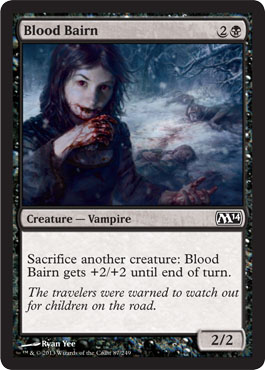
Blood Bairn—This art is the creepiest! Why’d they have to make it a child? Anyway, sac outlets are traditionally good—especially with Pacifism and Claustrophobia in the set—so the Bairn (which, as I just discovered, is a Scottish and North English word for “child”; so, “Blood Child”—weird) is somewhat better than it might be in, say, M13. It combos with Tenacious Dead, granting you +2/+2 for every spare 1B you have hanging around. Finally, while a 2/2 for three isn’t the best, I’d be happy to run this kid and find out what kind of value I can get out of her.
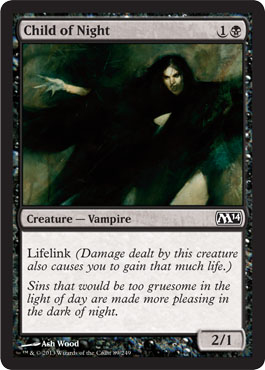
Child of Night—It’s great to see this simple, yet surprisingly powerful common reprinted. She’s yet another creature that combos well with Lightning Talons and Trollhide. Even with unsuited, she’ll trade for plenty of creatures and provide a healthy dollop of life before dying. (ZB)
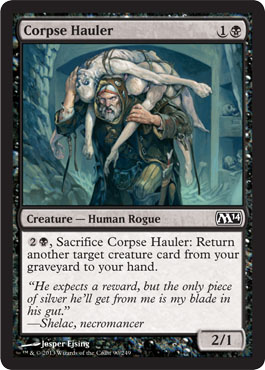
Corpse Hauler—This is an excellent card. 1B for a 2/1 is a great beater, and then, when he becomes useless, you can get back your best creature who’s bit the dust. A return-from-graveyard effect is often something that hangs out as my 24th card, and usually gets cut, so it’s cool to have this effect stapled onto a totally fine creature. (HRS)
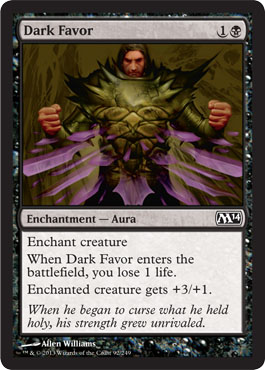
Dark Favor—If you’re feeling aggressive and don’t mind risking a two-for-one in your opponent’s favor, then Dark Favor is for you. Toss this on a flier or Phantom Warrior and you’ve built your own Madcap Skills. If you’re not running cheap, evasive threats and playing very aggressively, I’ll do you a favor and recommend you keep these in the sideboard. (ZB)
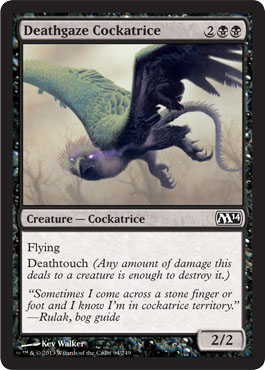
Deathgaze Cockatrice—Awesome art. Cockatrice costs a bit much, but he kills—well, anything. I doubt he’ll often live long, though, as your opponent is likely to just bite the bullet and trade with this guy at his or her first opportunity. And, having spent four mana on Cockatrice, you’re probably not getting a great rate on the trade. (HRS)

Duress—While Duress is a constructed staple, even there it’s always a sideboard card. I’ll rarely bring this out of the board unless there’s something I need to deal with that I can’t deal with otherwise. Perhaps if my opponent is a spell-heavy deck I’ll use this as a one-for-one trade that gives me some information, but this has such a high chance of whiffing that I’d rather not take the chance. (ZB)
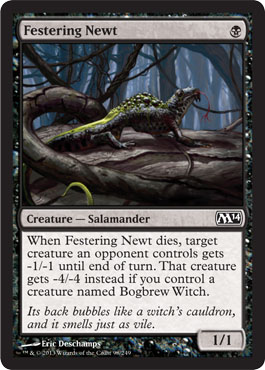
Festering Newt—Yeah, Festering Newt! One of my favorite cards in the set, alongside Bogbrew Witch and her Bubbling Cauldron. (Sure, it’s a little weird that witches and newts are running around in a world with Slivers, but them’s the breaks, I guess.) I also love that he’s a salamander. Regardless, in terms of card quality, just by himself he’s totally fine. He trades up for bears, often gets in unblockably against a field of X/1s, and if you have a Witch he’s just gravy. Disgusting, lizard-flavored gravy. (HRS)
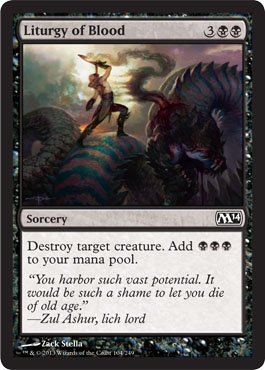
Liturgy of Blood—This is what common removal looks like these days: sorcery speed, expensive, and still good enough to play in your maindeck. Five mana: kill a guy is good enough in Limited, and if you can use the mana, this card is Doom Blade without the pesky nonblack clause. This gets my vote for best black common. (ZB)
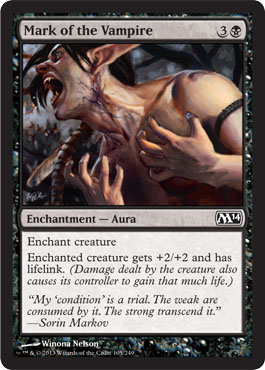
Mark of the Vampire—Mark of the Vampire has been strong in previous sets, and—in the right spot—I think it will be strong in this one. It just has an incredible ability to flip races, if you can pick your spots and put it on the right guy at the right time. [INSERT STANDARD AURA WARNINGS HERE.] (HRS)
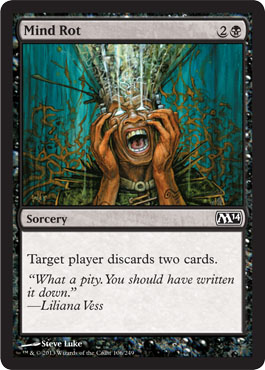
Mind Rot—Never great, but never terrible, Mind Rot flicks in and out of sideboards. If you’re on the draw and it’s a slow matchup, Mind Rot can wreck your opponent’s plans. If you fire it off too early or too late, you might trade a card for lands that your opponent didn’t need. It’s a low pick in draft, a borderline playable for the maindeck, and a reasonable sideboard option. (ZB)
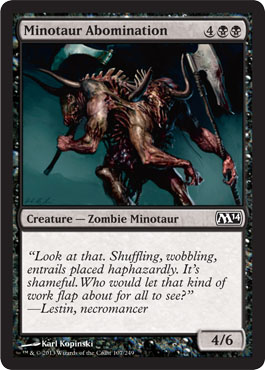
Minotaur Abomination—What a weird card! I think this is another instance of the change Wizards is making to black creatures’ standard power and toughness ratio, the first instance of which was the 1/3 Bane Alley Blackguard for 1B. In Dragon’s Maze, we had Armored Wolf-Rider, also a 4/6, for 3WG, which of course is a mana cheaper—but he was still a serious beater when he came down. The difference between a five- and a six-drop is big, though, and you’re not going to want more than one or two of these, if you have nothing better to do at that spot on the curve—but I definitely see this passing the “groan test,” meaning you’re not going to be happy when you see it hit the table across from you. Four power also looks like it’s going to punch through quite a lot in M14. (HRS)
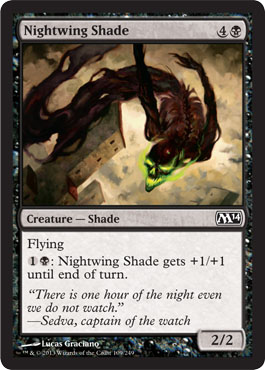
Nightwing Shade—Five mana is a lot of mana for a 2/2 flying. In a very slow match, this can dominate the skies, but in anything faster than that, you’ll have to choose between casting spells, holding up mana to block, and attacking with your expensive Wind Drake. I won’t draft this highly and won’t likely put multiple copies of this in a deck. (ZB)
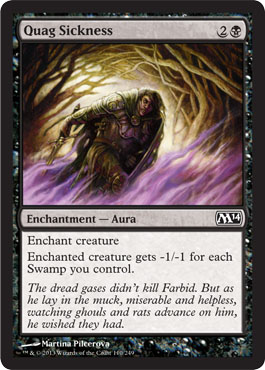
Quag Sickness—Obviously this is useless on the splash, but in a two-color deck with a regular number of Swamps, it basically kills anything, and scales while it does it. It’s good that Quag Sickness is in the set, as black drafters aren’t going to be seeing as many Doom Blades in M14 as they did Murders in M13, as the former are going to get snapped up by anyone looking to splash premium removal. (One caveat, though: There is significantly less mana-fixing in this set, with no dual lands, and only Shimmering Grotto and Darksteel Ingot for any-color fixing, both at uncommon. Who knows? Maybe splashing won’t be as viable in this set.) (HRS)
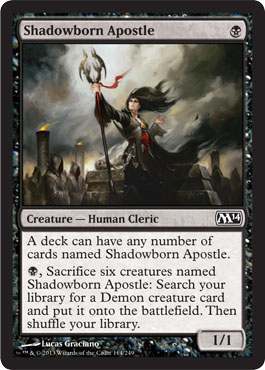
Shadowborn Apostle—Relentless Rats have new friends… in the sideboard. Even if you manage to get six or more of these and Shadowborn Demon, you still need to draw and cast six of them, spending seven mana to find your five-mana Demon. While they have nifty flavor, these are last picks. (ZB)
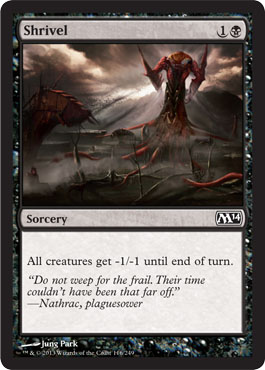
Shrivel—Ugh, this seems like a useless card. It couldn’t be instant? And it hits your guys as well. So basically the best-case scenario for this card is you make a bunch of bad attacks, lose all your guys, and then follow it up in your second main phase with this card, clearing their board as well. If you can reliably set up that sort of thing, this is a powerful effect—and I suppose you could just use this as a conditional mini-Barter in Blood … but if they don’t play X/1s, your plan is screwed. As it is, I think this is strictly a sideboard card against opponents with a bunch of one-toughness guys. (HRS)
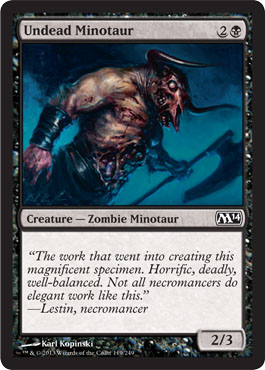
Undead Minotaur—Hurloon Minotaur has seen better days. It does a good job of blocking all those pesky 2/1s and 2/2s. Black seems one of the slower colors and this magnificent specimen can buy you much-needed time. Not a high pick by any stretch, but a serviceable creature. (ZB)
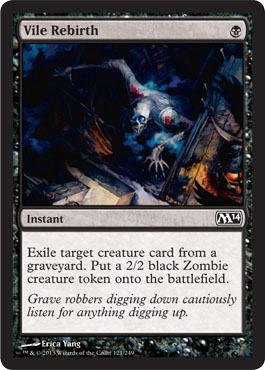
Vile Rebirth—I really wanted to like this card when it debuted in M13, but it never really seemed to do much. Unfortunately I think it’s probably going to meet the same fate in M14 as well. The effect is mini-powerful, making a 2/2 for B at instant-speed, but sometimes it can 100% do nothing, and that’s not what I want out of a card. (HRS)
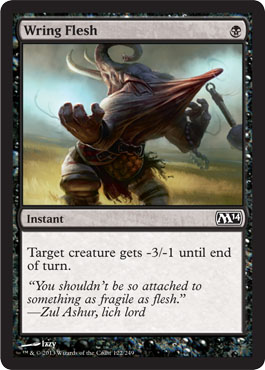
Wring Flesh—This kills seventeen common creatures, notably Trained Condor, Child of Night, and Regathan Firecat. It also allows your Undead Minotaur to eat Marauding Maulhorn. It won’t often be unconditional removal, but it should lead to plenty of favorable combat situations. And hey, it’s much better than Fatal Fumes. (ZB)
RED
Academy Raider—They couldn’t have at least made him a 2/1? Sheesh. 2R for a 1/1, even with intimidate, and even with his “rummage” ability, is just way not good. Also it’s not really what red, the color of aggression, wants to be doing, I don’t think. Maybe you could set up som strange WR or UR control deck, featuring this guy—but then that plan kind of all goes out the window if your opponent happens to have red creatures or 1/1 Sliver artifacts to block this dude with. Cool flavor, but I’m going to pass on this one. (HRS)
Act of Treason—Threaten effects are in most contemporary sets and vary in efficacy depending on how aggressive the format is. With creatures like Marauding Maulhorn, Regathan Firecat, Blur Sliver, and Goblin Shortcutter, I’d expect red aggro decks to want one or two of these as finishers. A more controlling red deck (that prioritizes red’s solid removal, rather than its aggressive creatures) likely has no business running this (unless it’s stealing creatures and sacrificing them to Blood Bairn). (ZB)
Blur Sliver—Man, the Slivers are looking good. A 2/2 bear with haste for three, that grants all of your other Silvers haste? Definitely. 2R for a bear isn’t ideal, but consider that he just kind of hides out until it’s time to attack (on T3), and I think that mitigates the cost. (HRS)
Canyon Minotaur—Ah, Hill Giant. Always serviceable, never great. It’s a bit slow for aggressive decks and underwhelming for slower decks, but can fit into either. It’s larger than the average creature, but with cards like Goblin Shortcutter, Trained Condor, and Master of Diversions, Canyon Minotaur might not be blocking as often as it usually does. This often makes my 23, but it’s not a high draft pick and may remain in the canyon near Brittle Bridge (aka the sideboard). (ZB)
Chandra’s Outrage—Red mages are going to love scorching Giant Spiders and Rumbling Baloths with this card, as they’ve always done. Six damage for four mana, even if two of it is RR, is great. Premium removal. (HRS)
Cyclops Tyrant—Flavorwise, this is a home run: It’s too big and angry to see the little creatures running between its legs. Otherwise, this Cyclops can tyrannize your sideboard. Six mana is too much to pay for a terrible blocker (it can only profitably block Canyon Minotaur, Pitchburn Devils, Sporemound, Siege Mastodon, Marauding Maulhorn, and itself) or a Bladetusk Boar. I’d be unhappy if this made it into my maindeck. (ZB)
Demolish—Do not play. I suppose you could board it in against Mutavault or Haunted Plate Mail—but really, why do you A) care about a bear so much, and B) just play Smelt. (HRS)
Dragon Hatchling—While Firebreathing on a flier can quickly slay an unprepared opponent, having to spend mana every turn in order to get anything from this dragon is a tall order. It’s usually better to curve out and deploy a creature every turn than to invest an entire turn into doing three or four damage. Then again, if you’re flooding out or have excess mana, this hatchling will be happy to use it. This isn’t a high draft pick and it’s terrible in multiples, but I wouldn’t be surprised to see one of these in my deck. (ZB)
Goblin Shortcutter—Now this is what red wants to be doing. The power and toughness are fine for the cost, and his tempo ability keeps up the aggression and bends the race in red’s favor, helping dodge Angelic Walls and bigger green creatures. (HRS)
Lava Axe—Like Act of Treason and Disperse, this is a pure tempo spell. Being slower than both, I’m less excited about putting it in my decks (though it is better against decks that flood the board with creatures—here’s looking at you, Sporemound). One can always go deep and play the 4x Lava Axe, 4x Archaeomancer deck. Play one, maybe two of these, and only as late additions to an aggressive deck. (ZB)
Lightning Talons—I don’t think this is a great card. Sure, Madcap Skills was good, but that cost one less mana and kind of made your guy pseudo-unblockable. I suppose first strike will also do that, but it just feels too fragile—more fragile than Divine Favor and Mark of the Vampire—to be good. You can still put this on a 2/1 and then your opponent just Shocks him out for the two-for-one. (HRS)
Note from Zach: Of all the commons in M14, Hunter and I had our biggest (and only) disagreement on Lightning Talons. It’s worse at evasively damaging your opponent than Madcap Skills and definitely invites a two-for-one if your opponent has a timely Shock or Celestial Flare. However, if you put this on a Child of Night, Dawnstrike Paladin, Griffin Sentinel, or Gladecover Scout and your opponent doesn’t have an answer, you win the game outright. As we learned in M13’s Mark of the Vampire, gaining a lot of life and applying lots of pressure can mitigate the card disadvantage of an enchanted creature dying. I won’t draft Lightning Talons highly, and it won’t always make my deck, but it seems very powerful nonetheless.(ZB)
Marauding Maulhorn—This beast is enormous! It’s a red creature with five power that doesn’t have one toughness! Sure, it has a “downside,” but a behemoth like this is meant to attack every turn. The only common in M14 that can profitably block this (by itself) is the expensive Minotaur Abomination, and if your opponent is double-blocking, you’ll likely get a two-for-one (or can Shock or Chandra’s Outrage a blocker for a two-for-one).
Despite being a big dumb thing, Marauding Maulhorn gets my vote for red’s best common creature. (ZB)
Pitchburn Devils—In its OG set, Pitchburn Devils was strong, but always seemed a bit too slow and non-synergistic, because “Devils” wasn’t really a thing on the Zombie-, Vampire-, and Werewolf-infested plane. Where it was best was as a curve-topper for red decks that wanted to dramatically and quickly lower opponents’ life totals, and then basically sit on the table as on-board burn. Any other use, like if you really need the 3/3 body, and I think things are starting to go south (meaning to hell). (HRS)
Regathan Firecat—This kitty is for the very aggressive decks (or ones that want to block Rumbling Baloth). Its low toughness means it’ll often trade down in combat or get eaten by a Capashen Knight. It also shares the three-slot with Blur Sliver, and unless you can get in two hits with Regathan Firecat, then Blur Sliver will do more damage to your opponent (and accordingly, be a better aggressive card). Neither a high pick nor a terrible one, Fire-kitty is a serviceable common. (ZB)
Seismic Stomp—This is probably going to end games. Maybe it’s a blind spot in my game, but I don’t like including cards in my decks that have the potentially to not do anything. Here’s a better explanation: Recent new Limited Resources co-host Brian Wong was explaining his system for card evaluation on a recent show. He said there are four situations to consider for each card: Is it good in the early game? Is it good when the board is at parity? Is it good when you are behind? And is it good when you are winning? The last category is obviously what this card is intended for, as a way to simply close out games—but this is the very category that Brian puts the least stock in, given that, if you have already crafted a winning board state, virtually any card (as long as it does something) can help push you over the top. That’s not to say that this card doesn’t do that job exceptionally well—but it also flatlines on each of the other three situations: It literally does nothing in the early or mid-game, and it actively hurts you (because it’s not a creature or something that affects the board) when you are behind. And it’s for these reasons that I’m going to take a stand and say pass on this card. Get something that works in more than one situation. (HRS)
Shock—Cheap, instant-speed removal is a good thing to have. Shock kills 32 out of 53 common creatures (though Predator Sliver, Blood Bairn, and Nightwing Shade might get out of range). It gets my vote for best red common and is likely the best common removal spell (though Chandra’s Outrage and Liturgy of Blood kill more things). (ZB)
Smelt—A fine sideboard card, although I really don’t ever bring something like this in unless my opponent has 2+ artifacts I really need to kill. (HRS)
Striking Sliver—This should have been Predator Sliver. It’s clearly a Predator (and apparently a sliver). A 1/1 for one tends to be unplayable, but this sliver might have an edge on the competition. Combine it with any of the power-boosting slivers and suddenly your army is terrifyingly strong. In a dedicated red/x slivers deck, this is a clear inclusion (though a later pick than other slivers). In a red deck with Battle Sliver and a bunch of Blur Slivers, I might play this. If you’re not playing slivers, it’s three strikes for this and back to the sideboard. (ZB)
Thunder Strike—I like this better than Lightning Talons: It’s cheaper, it’s an instant, and it basically can act as a poor-man’s removal spell. It’s not a high pick, of course, but I would much rather have one of these in my deck than a three-mana aura. (HRS)
Wild Guess—Card drawing is always a good thing, and red Divination/Sign in Blood is card draw. The problem with Wild Guess is that aggressive red decks would rather cast creatures or burn spells than spend a turn drawing cards and that controlling red decks would rather have removal or actual card advantage (re:Divination). It’s at its best when digging you towards a Shivan Dragon or Ogre Battledriver. Wild Guess is a late pick that may fill out a maindeck or a sideboard. (ZB)
GREEN
Advocate of the Beast—“I am just a simple beast lawyer; your ways are strange and confusing to me!” With that old-school SNL reference out of the way, I’ll just say that this guy seems fine on his own, and super-sick with any number of beasts. It’s worth noting that the trigger happens on your end step, so you get the extra +1/+1 counter right away, as opposed to on your next upkeep. Not a world-eater by any means, but—especially as a common—will be the anchor for a strong RG deck. (HRS)
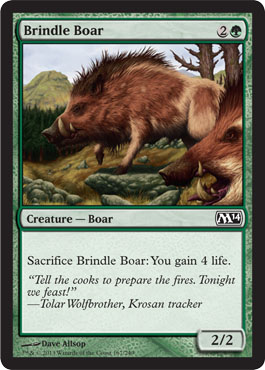
Brindle Boar—I expect more from green than a Gray Ogre with a minor ability. This is a likely a late pick that’ll come out of the sideboard if your opponent is very aggressive. I’d rather not have this in my main deck. (ZB)
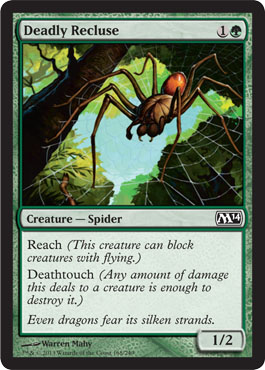
Deadly Recluse—AKA the Green Doom Blade, Recluse is fantastic two-drop, eating literally anything on the ground or in the skies. In a pinch, he can even get in for damage, although smart opponents will snap-block him at first opportunity, given that his value only goes up as the game goes on. (HRS)
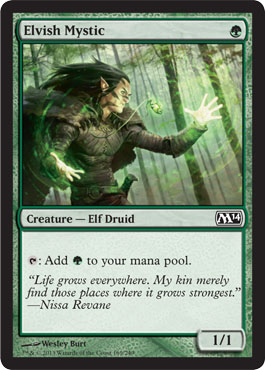
Elvish Mystic—Ooh, Llanowar Elf is back. Acceleration can be powerful in Limited, and a T1 accelerant is as fast as they come. The best ramp targets are at higher rarities, but at common, Elvish Mystic can let you activate Rootwalla and cast a spell or ramp into a T3 Rumbling Baloth. I expect that I’ll play a couple of these more often than not. (ZB)
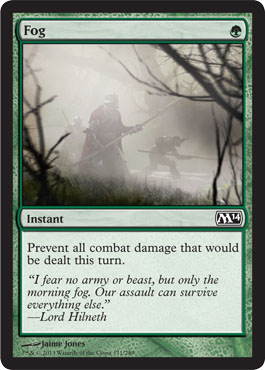
Fog—Do not play this card. That is all. (That said, I did board into a Hindervines in R10 of GP Pittsburgh, which pretty much single-handedly, if not won, then locked up my game.) Regardless, you should only ever board it in, and rarely even then. (HRS)
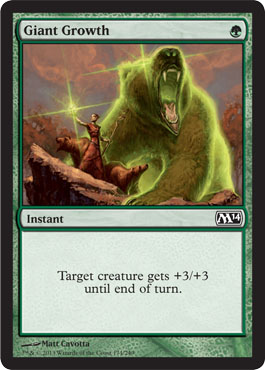
Giant Growth—The quintessential combat trick. It costs almost nothing to represent Giant Growth and can be a blowout in combat. It’s easy to draft a deck with too many spells and too few creatures, but if you’re looking for a noncreature, nonremoval spell, Giant Growth is a safe choice. (ZB)
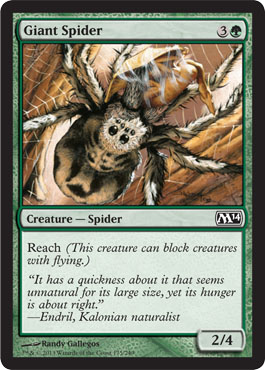
Giant Spider—He’s back, baby! I predict that good old G.S., who took his one and only core-set hiatus last year, will be just as much of a powerhouse as he’s always been—especially in a set that looks to be dominated by two- and three-power creatures. Remember in Modern Masters, when your opponent played Penumbra Spider, and you were just miserable? Well, even just the first half of P.S. is still pretty annoying. (HRS)
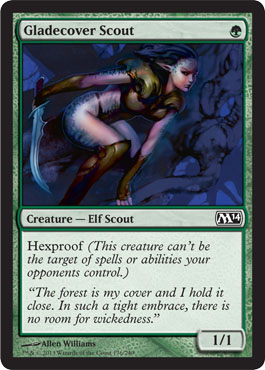
Gladecover Scout—A 1/1 for one tends to be horrible in Limited. Gladecover Scout is definite sideboard material, unless you’re running auras or other ways to empower creatures. A Lightning Talons can make her into a formidable fighter. As long as you play around Celestial Flare, you could build your own hexproof auras deck. Maybe that archetype will bear fruit. If you’re not trying to do that, then there’s no reason to run Gladecover Scout. (ZB)
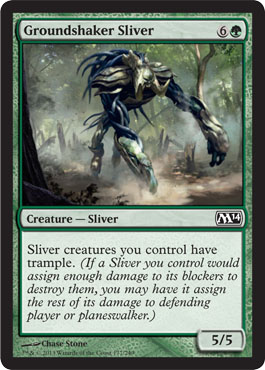
Groundshaker Sliver—Man, our first seven-drop, and he’s a beater. Still, a 5/5 for seven is well below the curve—and what other Slivers are really going to benefit from trample, anyway? Your other Groundshaker Slivers? That doesn’t seem like a great plan—and, unless this is a super-slow format (because there looks to be very little ramp), I’d recommend favoring the lower-cost Hive members. (HRS)
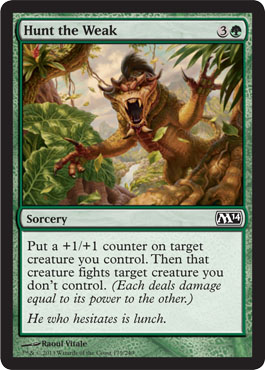
Hunt the Weak—Feral Contest is back and better templated. On the way hand, this is green removal. On the other hand, it’s slow, contingent on having a creature, and can be blown out by almost any other combat trick. If the format is slow enough, this could be a fine removal spell, but it’s unlikely to be particularly good. (ZB)
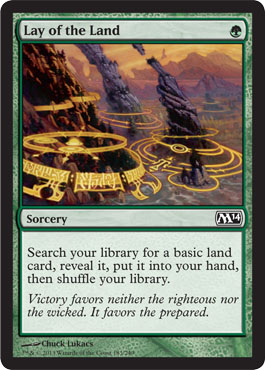
Lay of the Land—Like I said—very little ramp. This seems OK if you really need the fixing for a splash, but in a two-color deck I would always leave this out. It just doesn’t do enough. (HRS)
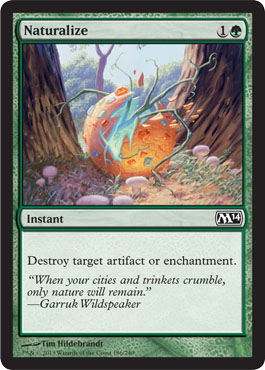
Naturalize—A classic sideboard card. If auras turn out to be sufficiently powerful and maindecked, then this could be good enough to maindeck, as well. (ZB)
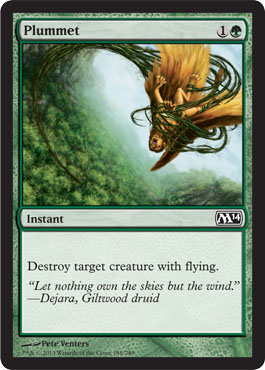
Plummet—An excellent sideboard card, and not even a shameful maindeck inclusion by any means, Plummet is something I definitely want to get at least one of in my draft, and will be extra-happy to see in my sealed pool. (HRS)
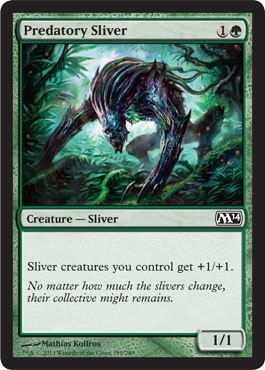
Predatory Sliver—This is the most essential (common) sliver. By itself, it’s a bear, which is fine. In multiples, it’s Timberpack Wolf. In a sliver deck, it’s Akroma, Angel of Wrath and Glorious Anthem. If it’s pack three and I’ve no slivers, I won’t prioritize this highly, but if I’m in or considering slivers, I’ll take this very highly. (ZB)
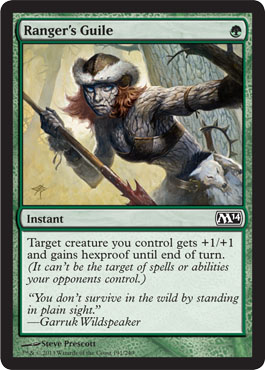
Ranger’s Guile—Pretty much a green Shielded Passage—but, like I said in my review of that card, I’m much less likely to want to maindeck this in M14 rather than, say, Gatecrash. I’m happy to board it in against decks with infinite removal, but otherwise I want more out of my combat tricks, especially in green. (HRS)
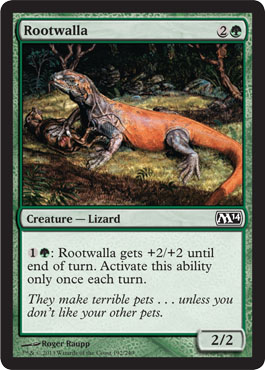
Rootwalla—As with Darkthicket Wolf, this should trade with whatever blocks it when unpumped, and eat whatever blocks it otherwise. I’m a fan and will likely take these reasonably highly, as I wouldn’t expect a [/mtg_card]Rootwalla[/mtg_card] to wheel. (ZB)
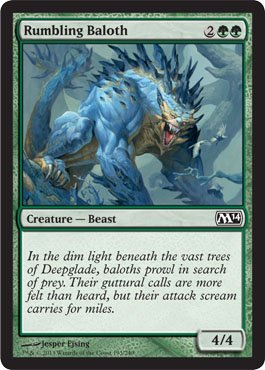
Rumbling Baloth—Now here’s a card. I wish there were some two-drop ramp, allowing the old 4/4 for four to come down a turn early, but sadly there’s not. This guy is going to be miserable for you, just accept it. Think about T2 the 3/3 for GG, T3 Advocate of the Beast, and then this guy, who insta-becomes a 5/5. I don’t see how anyone other than Doom_Blade.dek is stopping you. (HRS)
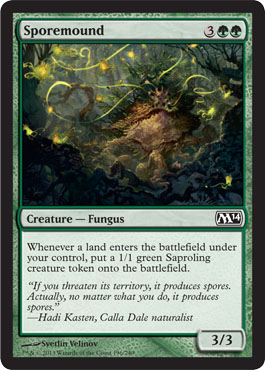
Sporemound—Repeatable token making at common? This is unusual. Sure, a 3/3 for five is slow (particularly for green), but in a slow green deck, this means you’re always drawing live (unintentional pun). You get chump blockers, an ever-growing army, or something to sac to Gnawing Zombie or Altar’s Reap. It’s a bit durdly—if the format is really aggressive, it should be way too slow to matter. However, if I’m looking to buy my deck some time, I’d be happy to give Sporemound a shot. (ZB)
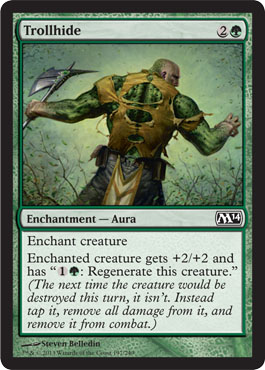
Trollhide—This is an aura I can get behind, given that, once you stick it, you can basically insure (other than Quag Sickness) that your beefed-up dude is going to stick around. Sadly there’s no Sacred Wolf in this set, which was a great target for the old Trollskin, but putting this on the aforementioned 3/3 for GG in lieu of the T3 Advocate is big game, allowing you to swing for an incredible five on T3. (HRS)
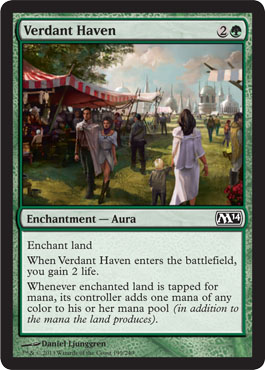
Verdant Haven—For my last card, let’s revisit a Gatecrash reprint. Verdant Haven was usually too durdly in a format full of Boros and Gruul aggro (though the Greenside Watcher/Verdant Haven/gate deck was amazing). Without battalion and bloodrush, Verdant Haven’s ramp, fixing, and tempo might be good enough to see serious play. Granted, there needs be cards worth ramping into from three mana. Serra Angel, Sengir Vampire, and even Groundshaker Sliver and Sporemound fit the bill. If you’re willing to eschew aggro and play a ramp/multicolor deck, Verdant Haven is for you. Let’s see how good that deck is this weekend!(ZB)
SLIVER CONSTRUCT (er… artifacts)
Sliver Construct—And that’s all we’ve got! This guy is good in the Sliver deck and fine everywhere else—be sure to bring him in to block opposing intimidate guys, if he’s not already in your maindeck. Not exciting by any means, but a totally reasonable 22nd or 23rd card. Tune in next Tuesday to Drawing Live for our review of M14’s uncommons! And good luck this weekend at your pre-release! (HRS)
23/17 is a Hipsters of the Coast column focused on Limited play—primarily draft and sealed, but also cubing, 2HG, and anything else we can come up with. The name refers to the “Golden Ratio” of a Limited deck: 23 spells and 17 lands.

